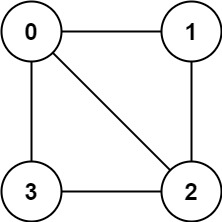⭐️⭐️⭐️
# 題目敘述
There is an undirected graph with n nodes, where each node is numbered between 0 and n - 1 . You are given a 2D array graph , where graph[u] is an array of nodes that node u is adjacent to. More formally, for each v in graph[u] , there is an undirected edge between node u and node v . The graph has the following properties:
- There are no self-edges (
graph[u]does not containu). - There are no parallel edges (
graph[u]does not contain duplicate values). - If
vis ingraph[u], thenuis ingraph[v](the graph is undirected). - The graph may not be connected, meaning there may be two nodes
uandvsuch that there is no path between them.
A graph is bipartite if the nodes can be partitioned into two independent sets A and B such that every edge in the graph connects a node in set A and a node in set B .
Return true if and only if it is bipartite.
# Example 1:

Input: graph = [[1,2,3],[0,2],[0,1,3],[0,2]]
Output: false
Explanation: There is no way to partition the nodes into two independent sets such that every edge connects a node in one and a node in the other.
# Example 2:

Input: graph = [[1,3],[0,2],[1,3],[0,2]]
Output: true
Explanation: We can partition the nodes into two sets: {0, 2} and {1, 3}.
# 解題思路
# Solution
class Solution { | |
public boolean isBipartite(int[][] graph) { | |
int n = graph.length; | |
int[] remeber = new int[n]; | |
// remeber graph index in which group, group A = 1, group B = -1 | |
for (int i = 0; i < n; i++) { | |
if (remeber[i] == 0 && !dfs(graph, remeber, i, 1)) | |
return false; | |
} | |
return true; | |
} | |
public boolean dfs(int[][] graph, int[] remeber, int node, int group) { | |
if (remeber[node] != 0) | |
return remeber[node] == group; | |
remeber[node] = group; | |
for (int neighbor : graph[node]) { | |
if (!dfs(graph, remeber, neighbor, -group)) | |
return false; | |
} | |
// if neighbor node is not in same group, mean it can divide to two group. | |
return true; | |
} | |
} |
單字
** **
!! !!
片語 & 搭配詞
!! !!
